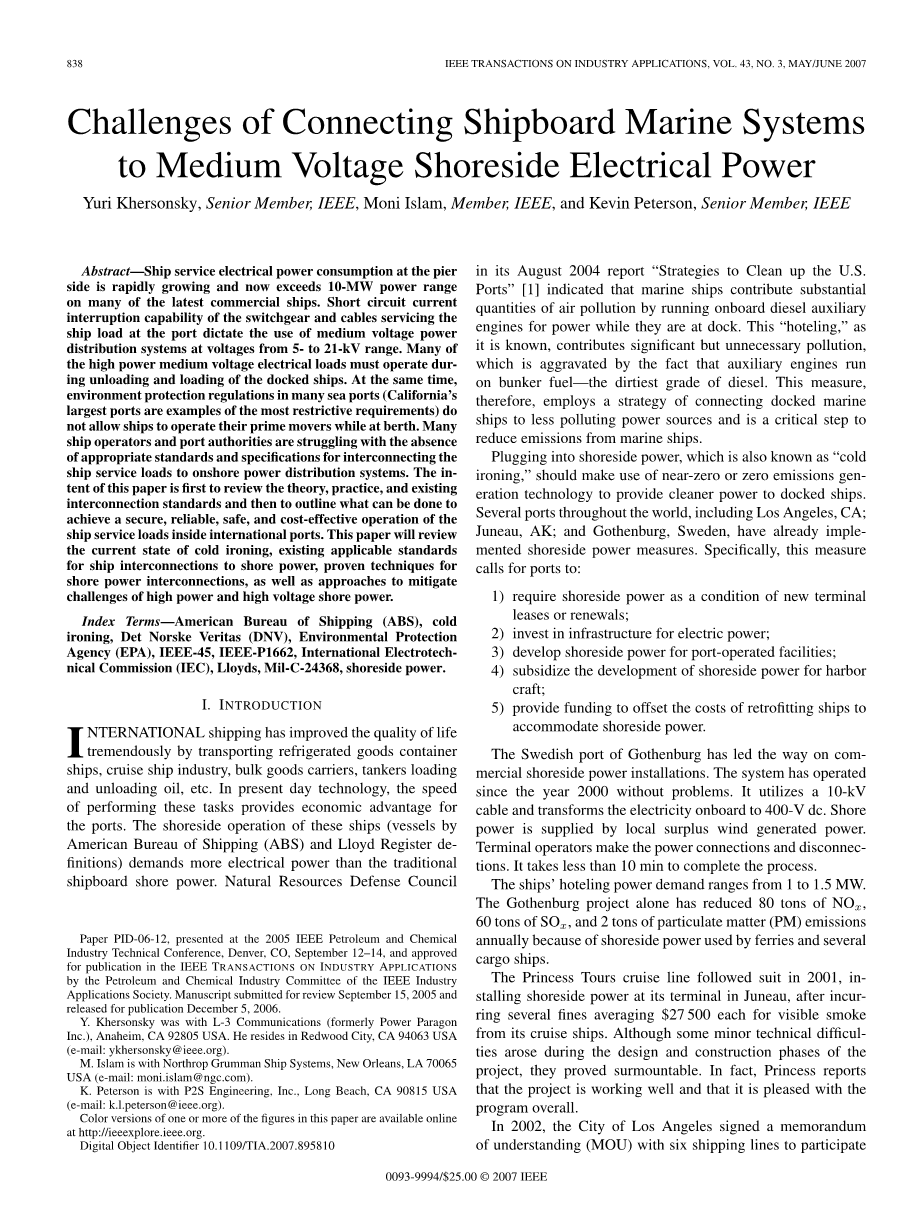

英语原文共 7 页,剩余内容已隐藏,支付完成后下载完整资料
连接船舶系统与中压岸电的挑战
Yuri Khersonsky,IEEE高级会员,Moni Islam,IEEE会员,和Kevin Peterson,IEEE高级会员
Abstract—Ship service electrical power consumption at the pier side is rapidly growing and now exceeds 10-MW power range on many of the latest commercial ships. Short circuit current interruption capability of the switch gear and cables servicing the ship load at the port dictate the use of medium voltage power distribution systems at voltages from 5- to 21-kV range. Many of the high power medium voltage electrical loads must operate during unloading and loading of the docked ships. At the same time,environment protection regulations in many seaports(Californiarsquo;slargest ports are examples of the most restrictive requirements) do not allow ships to operate their prime movers while at berth. Many ship operators and port authorities are struggling with the absence ofappropriatestandardsandspecificationsforinterconnectingthe ship service loads to onshore power distribution systems. The intent of this paper is first to review the theory, practice, and existing interconnection standards and then to outline what can be done to achieve a secure, reliable, safe, and cost-effective operation of the ship service loads inside international ports. This paper will review
the current state of cold ironing, existing applicable standards for ship interconnections to shore power, proven techniques for shore power interconnections, as well as approaches to mitigate
challenges of high power and high voltage shore power. Index Terms—American Bureau of Shipping (ABS), cold ironing, Det Norske Veritas (DNV), Environmental Protection Agency (EPA), IEEE-45, IEEE-P1662, International Electrotech nical Commission (IEC), Lloyds, Mil-C-24368, shoreside power.
摘要——在码头船舶正常运行所需电力消耗在快速增长,现在在许多最新的商业船舶上电力消耗功率范围已经超过 10兆瓦的,港口规定船舶分配系统的开关和电缆能承受的短路中断电流电压是在5-21千瓦范围内。在停泊装卸货物时许多大功率中压电力负载必须使用。同时,在许多港口环境保护管理办法(加利福尼亚最大的港口就是要求最严格的例子)不允许船舶停泊时使用原动力设备。许多船舶运营商和港口当局正在努力去填补船舶正常运行负载与岸电分配系统连接的适当标准与说明的空缺。本文的目的是首先回顾理论,实践和现有的连接标准。然后勾勒出在国际港口能够做到安全,可靠和高效的船舶服务负载操作。本文将回顾现行的岸电技术的情况,现有的船舶连接岸电的适应标准,岸电连接的成熟技术,以及减轻高功率和高压岸电挑战的方法。
索引词——美国航运局,岸电,挪威船级社,环境保护署,IEEE-45,IEEE-P1662,国际电力委员会,劳埃德,Mil-C-24368,岸电。
I. I NTRODUCTION
INTERNATIONAL shipping has improved the quality of life tremendously by transporting refrigerated goods container ships, cruise ship industry, bulk goods carriers, tankers loading and unloading oil, etc. In present day technology, the speed of performing these tasks provides economic advantage for the ports. The shore side operation of these ships (vessels by American Bureau of Shipping (ABS) and Lloyd Register definitions) demands more electrical power than the traditional
shipboard shore power. Natural Resources Defense Council in its August 2004 report “Strategies to Clean up the U.S.Ports” [1] indicated that marine ships contribute substantial quantities of air pollution by running on board diesel auxiliary engines for power while they are at dock. This “hoteling,” as it is known, contributes significant but unnecessary pollution,which is aggravated by the fact that auxiliary engines run on bunker fuel—the dirtiest grade of diesel. This measure,therefore, employs a strategy of connecting docked marine ships to less polluting power sources and is a critical step to reduce emissions from marine ships.
1.国际
国际航运通过运输冷藏货物的集装箱船,邮轮业,散货船,装卸的邮轮等已经极大的提高了生活质量。目前现有的技术和港口能快速完成这些任务为港口提供了经济优势。这些船舶(在美国航运局和劳埃德注册的船舶)在港操作比传统的船用岸电需要更多的电力。自然资源保护委员会在其2004年八月的报告——美国港口清理[1]策略中指出船舶在港运行船上辅机提供能量所造成的实际空气污染量。众所周知,这个“临时工作间”,通过辅机燃用低劣的船用重油
造成极大的但是不必要的更严重的污染。因此通过采用一种连接靠港船舶从船舶上减小污染源的措施是关键性的一步。
Plugging into shoreside power, which is also known as “cold ironing,” should make use of near-zero or zero emissions generation technology to provide cleaner power to docked ships.
Several ports throughout the world,including Los Angeles,CA;
Juneau, AK; and Gothenburg, Sweden, have already implemented shoreside power measures. Specifically, this measure calls for ports to:
1) require shoreside power as a condition of new terminal
leases or renewals;
2) invest in infrastructure for electric power;
3) develop shoreside power for port-operated facilities;
4) subsidize the development of shoreside power for harbor
craft;
5) provide funding to offset the costs of retrofitting ships to
accommodate shoreside power.
接通岸电,这个也被称为“岸电”,应该利用接近零或者零排放发电技术,为靠港船舶提供更洁净的电力。遍布世界的几个港口,包括加利福尼亚州洛杉矶市CA港口,朱诺AK港口和瑞典哥德堡的港口已经实施了岸电措施,具体而言,这项措施呼吁港口: 1)要求岸电作为新港口租赁或续约的条件;2)为岸电基础设施投资;3)建设岸电的港口操作设备;4)资助发展岸电的港口工艺;5)为接受岸电提供船舶改造费用。
The Swedish port of Gothenburg has led the way on com-mercial shoreside power installations. The system has operated since the year 2000 without problems. It utilizes a 10-kV cable and transforms the electricity onboard to 400-V dc. Shore power is supplied by local surplus wind generated power.Terminal operators make the power connections and disconnections. It takes less than 10 min to complete the process.The shipsrsquo; hoteling power demand ranges from 1 to 1.5 MW.The Gothenburg project alone has reduced 80 tons of NO x ,60 tons of SO x , and 2 tons of particulate matter (PM) emissionsannually because of shoreside power used by ferries and several cargo ships.
瑞典的哥德堡港口率先在安装了商业岸电装置,自从2000安装到现在,这个系统没有发生任何问题,它使用一个10kv的电缆并将上船电力转换成400v直流电。岸电是通过当地过剩的风力发电提供。终端操作员控制电力的连接与断开,完成这个过程花费的时间不超过10分钟。船舶的住宿功率要求范围是1-1.5mw。在哥德堡项目中因为渡船和几个货船采用岸每年就减少了80tNOx、60tSOx和2t颗粒物的排放量。
The Princess Tours cruise line followed suit in 2001, installing shoreside power at its terminal in Juneau, after incurring several fines averaging $27500 each for visible smoke from its cruise ships. Although some minor technical difficulties arose during the design and construction phases of the
project, they proved surmountable. In fact, Princess reports th
剩余内容已隐藏,支付完成后下载完整资料
资料编号:[146249],资料为PDF文档或Word文档,PDF文档可免费转换为Word


